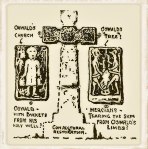
Carving on Tower of St Oswald’s Church at Winwick, Lancashire.
OS grid reference: SJ 6038 9283. St Oswald’s parish church is located on Church Walk, off Golborne Road, in the middle of Winwick Village, in Lancashire (it used to be in Cheshire). It is a largerly 14th century building on the site of a pre-Conquest chapel and prior to that a pre-Christian, pagan temple. The church houses an 8th-9th century cross arm section, an ancient font, old inscriptions and a Medieval rood beam. And on the exterior tower wall there is an interesting carving of a pig next to a statue of St Anthony. According to legend, Oswald, king of Northumbria came to Winwick a few years before he met his death at the hands of King Penda of Mercia, near Oswestry, or according to some historians, he was killed in battle at Maserfield in Shropshire, in 642 AD, at the age of 38. There is a St Oswald’s Well ½ a mile to the north of Winwick at Hermitage Green; the town of Newton-le-Willows is 1 mile to the north on the A49 road.

Winwick Church Cross (Illustration/Diagram.
In 1873 part of a Saxon cross was dug up in the churchyard and for some years it was kept there, but it was eventually brought into the church and is now displayed on the window-sill in the Gerard Chapel at the NE side. These are the arms of a tall Saxon preaching cross, dating maybe from the 8th century, which may even have been used by St Oswald himself? Although the carvings are faint, most can still be made out. The front face has key-patterns, and there is interlacing and scroll-work. At one end a priest carries two bells or maybe water containers (St Oswald’s Well), while at the other end a saint, probably Oswald, is being martyrd and two soldiers are hanging the saint up-side down from a tree – each having a foot on his face. On the reverse side: three creatures with legs and tails coiled together, and a more recent inscription to the memory of Roger Lowe, who gave this cross as a gravestone in 1793.
The church font on a modern pedestal in the Gerard Chapel could date from the 11th century, or a little earlier, but it was damaged by Puritans; and there is still some Norman masonry to be seen. In the vestry there is part of the Medieval rood beem – the rood loft having long since been destroyed; while the Oak lectern is recent but it has a canopy and carved figure of St Oswald. There is also a Jesse window, and two interesting carved heads at the bases of two columns (north aisle) could be Celtic in origin (Mark Olly, 1997). In 1643 and 1648 two Civil War battles took place at Winwick and the church of St Oswald was used as a stable by soldiers.
On the outside tower wall (west side) there is a carving of a pig next to statues of St Anthony and St Oswald. Legend says that a pig was instrumental in the building of the first church. According to author Ken Howarth ‘Ghosts, Traditions & Legends Of Old Lancashire’, “A pig was seen running away from the site of the new church being built to commemorate St Oswald…..as it ran away, it was heard to scream “We-ee-wick, we-ee-wick, we-ee-wick” from whence the town, according to this particular legend, got its name. The pig then took up a stone in its mouth and carried it to the spot where the church should be built. This remarkable animal apart from talking, then moved all the stones the men had laid to the new sacred site.” But Howarth tells us that another source says: “it is the pig of St Anthony that is preserved in the west front of the church.” The pig is the symbol/badge of St Anthony of Egypt, who died in the mid-4th century AD.
In 1828 three human skeletons of gigantic proportions were discovered 8-10 feet below the chancel. They are thought to have dated from the pre-Christian period and to have been associated with a Druidical temple which stood on the site; maybe they were sacrificial victims? The place of St Oswald’s martyrdom is considered by some historians to be at Makerfield near Winwick, Lancashire, rather than Maserfield in Shropshire.
Sources:
Fields, Kenneth., Lancashire Magic & Mystery, Sigma Leisure, Wilmslow, Cheshire, 1998.
Howarth, Ken., Ghosts, Traditions & Legends Of Old Lancashire, Sigma Leisure, Wilmslow, Cheshire, 1993.
http://newton-le-willows.com/?p=860
http://www.mysteriousbritain.co.uk/england/cheshire/legends/st-oswalds-church-winwick.html
Olly, Mark., Celtic Warrington And Other Mysteries – Book One – North To East, Churnet Valley Books, Leek, Staffordshire, 1997.

February 18, 2016 at 11:02 pm
Thank you very much Sally for your interesting comment. I would agree with what you say.
LikeLike
February 18, 2016 at 4:19 am
Reblogged this on Lenora's Culture Center and Foray into History.
LikeLike
February 14, 2016 at 2:38 am
This is not the only instance of the burial of giants by Druids or people of such eras. Interesting that there is often more than one skeleton involved. There are, of course, certain medical conditions which cause people to over-grow and would run in a family, which would account for the groups. Nowadays the condition is understood and treated, but historically it would be the source of wonderment and, perhaps, fear. ???
LikeLike